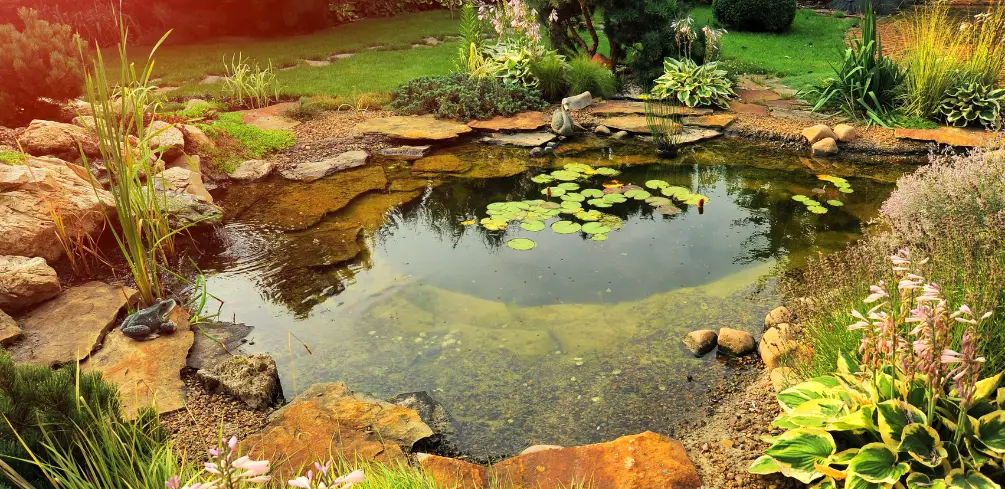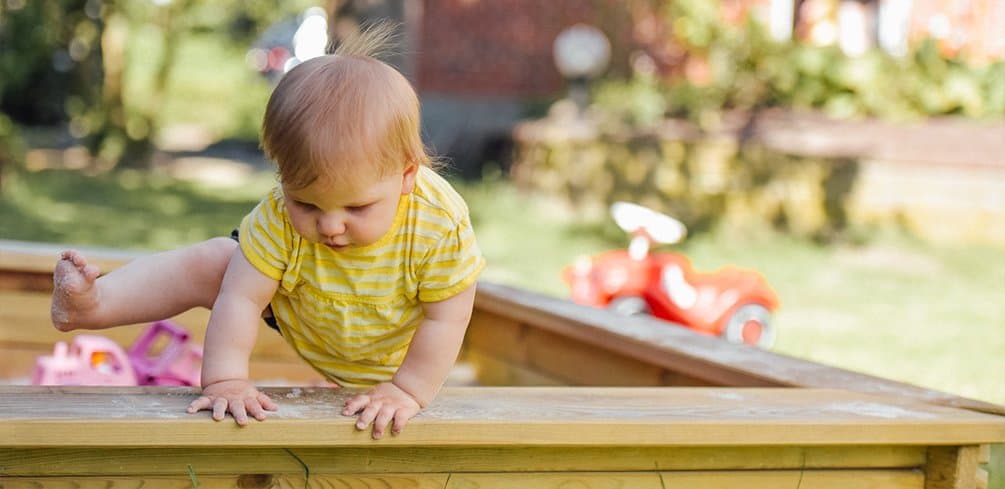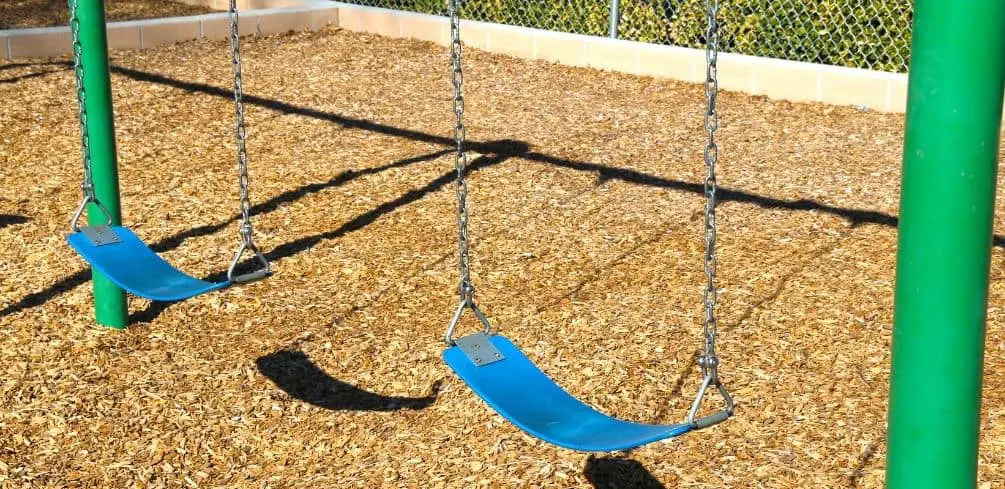Imagine, if you will, a tiny world in your own backyard, a bustling microcosm where every living being has a role to play. Picture the water lilies reaching out for sunlight while fish dart between submerged roots and rocks.
This is your backyard pond, an oasis of life that’s more complex than it first appears. It hums with activity day and night as each element interacts with the other in a delicate dance of survival and growth.
Now consider that this miniature sanctuary might be more than just an ornamental feature or hobby.
Your backyard pond could be an ecosystem unto itself – a self-sustaining environment where life thrives through interaction and interdependence.
As you delve into understanding the various facets of this ecosystem – from the aquatic plants playing their part in oxygenating water to microorganisms breaking down waste – you’ll realize how delicately balanced everything is.
Understanding the Concept of an Ecosystem

Let’s dive right in and grasp the idea of what an ecosystem actually is, shall we?
An ecosystem can be defined as a complex network or interaction between different organisms and their physical environment. It comprises all living beings, from animals to plants and microorganisms, along with non-living components like water, air, and soil.
Ecosystem diversity refers to the variety of ecosystems present in a specific area. For example, a forest may contain several ecosystems such as rivers, ponds, soils, and tree canopies – each hosting unique communities of organisms interacting with one another and their environment.
Now that you’ve got the basic gist of an ecosystem, let’s delve deeper into its significance.
The concept of ‘Ecosystem services’ comes into play here – these are significant benefits humans derive from ecosystems. Ecosystem services can be direct, like food production, or indirect, like climate regulation.
They also include cultural benefits such as recreational enjoyment or spiritual enrichment. These services are essential for human survival and well-being since they provide us with food, clean air, and water, among many other things.
So how does this all relate back to our question about whether your backyard pond is an ecosystem?
Well, if you consider the definitions we’ve explored, you’ll find that it indeed fits the bill perfectly!
Your backyard pond could host algae (producers), amphibians such as frogs (consumers), and insects (decomposers) carrying out biological interactions amongst themselves while also interacting with non-living components like sunlight or rocks around them, thereby forming a small but dynamic ecosystem of its own!
This realization not only enriches your perspective towards nature but also underlines our responsibility to conserve these delicate networks, whether big or small, because every single one contributes significantly towards maintaining life on Earth!
The Role of Aquatic Plants

You might not realize it, but those aquatic plants you’ve been tending to play a crucial role in maintaining the delicate balance of your mini aquatic universe. Aquatic plants serve multiple functions that are essential for a healthy backyard pond ecosystem.
They provide habitat and food for many organisms living in the pond, from tiny insects to frogs and fish.
Additionally, they assist in oxygenating the water, which is vital for the survival of these creatures. Not only that, their root systems help stabilize the pond’s bottom and edges, reducing erosion and providing shelter for small critters.
Let’s take a closer look at how two specific aspects – plant propagation and algae control – contribute to this balance:
| Aspect | Explanation |
|---|---|
| Plant Propagation | Algae can quickly overtake a pond if left unchecked. However, aquatic plants compete with algae for nutrients in the water thus controlling their growth. Some species even release chemicals that hinder algae development making them excellent natural controllers |
| Algae Control | Algae can quickly overtake a pond if left unchecked. However, aquatic plants compete with algae for nutrients in the water thus controlling its growth. Some species even release chemicals that hinder algae development making them excellent natural controllers |
Now let’s delve into why understanding these roles matters when managing your backyard oasis effectively. A thriving population of diverse aquatic plants can significantly reduce the maintenance efforts needed, such as the manual removal of excess algae or the addition of artificial oxygenators.
Moreover, proper nurturing of your plant life contributes positively towards overall biodiversity within your backyard pond by attracting more wildlife species and promoting healthier populations among existing inhabitants.
All these factors combined make up an intricate web where everything is connected — underscoring how much those aquatic plants matter in preserving this miniature ecosystem you’ve created right in your backyard.
The Importance of Fish and Other Aquatic Animals

Just as aquatic plants play a pivotal role, so too does the vibrant community of fish and other aquatic animals that dart, dive, and dwell beneath the water’s surface.
These creatures aren’t just pretty to look at; they’re vital actors in the backyard pond ecosystem. They help maintain a healthy balance by controlling pests, recycling nutrients, and providing food for other wildlife.
Additionally, certain species can aid in algae control, which keeps your pond water clear.
To promote a thriving environment for your fish, consider these important factors:
- Fish Breeding Techniques: Understanding various breeding behaviors can improve survival rates among offspring.
- Aquatic Animal Diets: The diet won’t only affect their health but also influence the overall nutrient levels within the pond.
- Water Quality: Sufficient oxygen levels and appropriate pH balances are critical for survival.
- Predation Risk: Consider what measures you’ll take to protect your fish from predators like herons or raccoons.
- Suitable Habitat: Ensure there’s plenty of cover, such as rocks or vegetation, where they can hide or spawn.
Now let’s delve deeper into how these elements interact in your backyard pond ecosystem. By employing effective fish breeding techniques, you’re boosting population diversity, which consequently increases resilience against diseases or changing environmental conditions.
Feeding them an appropriate aquatic animal diet helps manage nutrient build-up within the system; overfeeding leads to excess waste that may result in harmful ammonia spikes or rampant algal growths – both detrimental events for any aquatic habitat.
Furthermore, ensuring good water quality with regular testing allows prompt intervention if necessary parameters drift outside optimal ranges.
Lastly, remember that creating habitats that offer shelter from predators while still allowing ample room for natural behaviors is essential for their well-being and longevity.
So you see, these lively residents do far more than simply add aesthetic appeal – they hold an integral role in maintaining an active and balanced backyard pond ecosystem.
The Function of Microorganisms
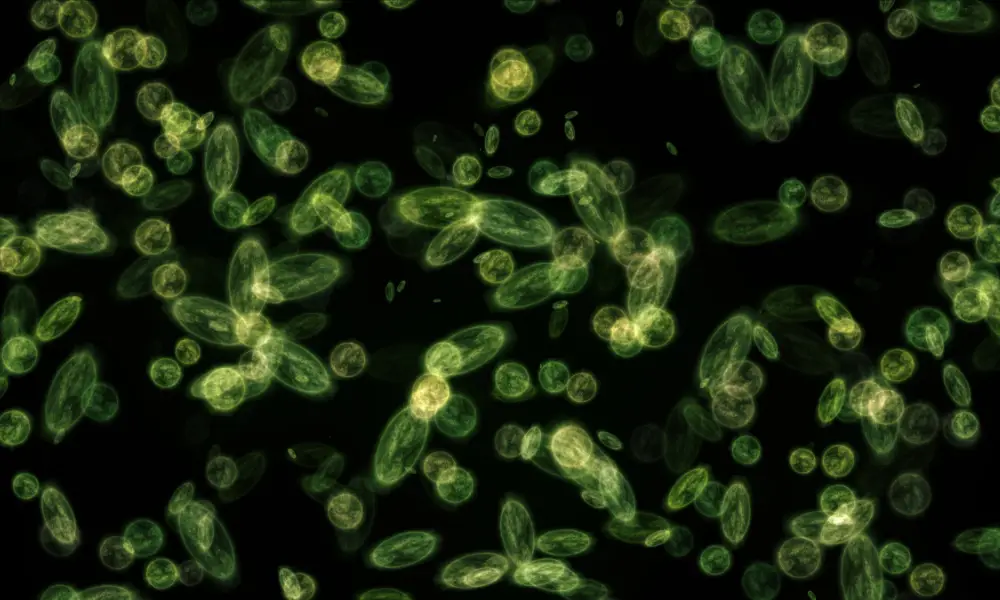
Diving even deeper beneath the surface, it’s in the microscopic world where some of the most crucial work takes place. Your backyard pond is teeming with microorganisms that play a vital role in maintaining its ecosystem.
They form an integral part of nutrient cycling and decomposition processes, contributing to the overall health and stability of your pond. Through their constant evolution, these microorganisms adapt to changes in the environment, ensuring they continue to serve their function effectively.
These invisible heroes are responsible for breaking down organic matter like dead plants and waste from fish or other aquatic animals into simpler substances.
This process not only cleanses your pond but also produces nutrients that are essential for plant growth.
| Microorganism’s Role | Breaks down complex organic material into simpler substances that can be utilized by plants |
|---|---|
| Decomposition | Breaks down complex organic material into simpler substances which can be utilized by plants |
| Disease Prevention | Certain types of bacteria compete with harmful pathogens for resources, thereby limiting their growth and preventing disease |
While we often associate microorganisms with diseases, many species found in your pond actually help prevent illnesses by competing for resources against pathogenic bacteria. By occupying space and consuming available nutrients, beneficial bacteria limit the growth potential of harmful ones.
This biological competition serves as a natural disease prevention strategy within your backyard pond ecosystem.
Understanding this dynamic interplay at a microscopic level can provide you with insights into how best to manage your backyard pond. It’s not just about having beautiful plants or lively fish – every organism plays its part, even those unseen.
Remember that maintaining balance is key; overpopulation or depletion of any one group can disrupt the entire system. Therefore, nourish this diversity because it is indeed what makes your backyard pond a vibrant and functional ecosystem.
Maintaining the Balance of Life in a Small-Scale Environment
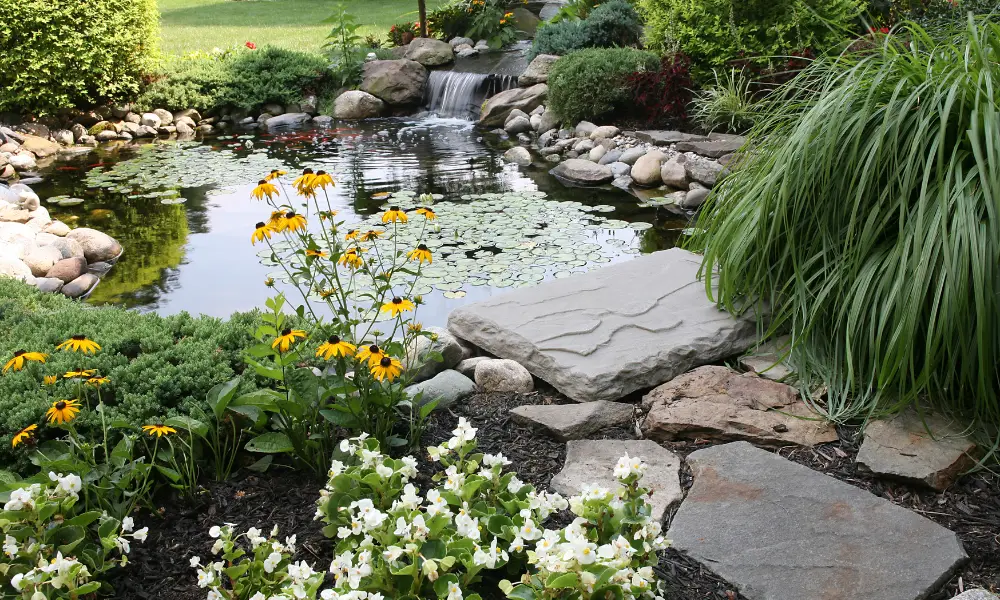
It’s a delicate dance, this task of keeping every microscopic and macroscopic life form in harmony in your own slice of nature. Your backyard pond isn’t just a decorative water feature; it’s an ecosystem teeming with life.
To maintain balance within this small-scale environment, you need to consider everything from the plants that provide oxygen to the fish that control insect populations.
- Pond Aeration Techniques: Just like land animals, aquatic creatures require oxygen to survive. Lack of proper aeration can create an inhospitable environment leading to unhealthy or dying species. An aerator or fountain not only adds aesthetic value but also facilitates the circulation and oxygenation process.
- Algae Control Methods: Algae is part of any natural water body; however, too many algae can suck out essential nutrients causing other plants and animals to starve. Physical removal, use of algaecide chemicals (sparingly!), and introduction of algae-eating species are some ways to control its growth.
- Water Quality Management: Regularly testing for pH levels, temperature changes, and ammonia content ensures optimal living conditions for pond inhabitants.
- Habitat Structure: Providing different depths within your pond can cater to the varying needs of diverse species while arranging rocks and plants creates hideouts for smaller organisms enhancing their survival rate.
The task at hand may seem daunting but remember; each effort brings you closer to a thriving backyard ecosystem where life flourishes harmoniously under your watchful eyes. It’s quite an accomplishment when all elements align perfectly.
The soundscape created by water moving through an aerator, the sight of vibrant greenery thriving amidst controlled algae growth, and glistening fish darting among strategically placed rocks—all testify to an ecosystem in the balance!
This is what makes hours spent on maintaining your pond worth it…and if you listen closely enough, you’ll hear nature singing her heartfelt thanks back at you!
Conclusion
You’ve now discovered the fascinating complexity of your backyard pond. It’s more than just water, plants, and fish—it’s an intricate ecosystem hosting countless forms of life. Did you know that a single teaspoon of pond water can contain up to 1 million microorganisms?
So next time you glance out at your tranquil water feature, remember it’s not just a pretty sight. It’s a bustling world in miniature, teeming with life and natural processes.
Your efforts in maintaining its balance directly protect this vital biodiversity hotspot right on your doorstep!

